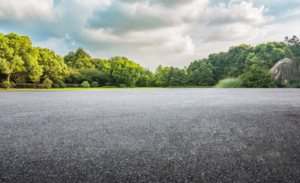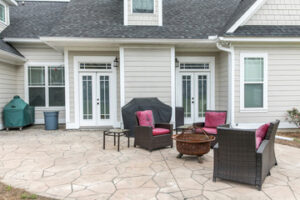A pavement is a durable surface material used to cover roads or airstrips. Its primary function is to distribute the applied vehicle loads through different layers. It should also provide an acceptable riding quality, good skid resistance, and favorable light-reflecting characteristics.
The pavement should withstand geographic, seasonal, and diurnal variations in temperature. This will ensure its long design life.

Asphalt is a versatile, affordable paving material that can be used for a wide range of road, highway and parking lot construction projects. It is also a cost-effective option for resurfacing existing pavements. Asphalt is also an environmentally friendly material that can be produced using a variety of sustainable practices. The Federal Highway Administration (FHWA) is currently testing full-scale highway sections that utilize recycled materials and low-temperature warm-mix production technologies to determine the optimal pairings of these two sustainable technologies.
One of the primary benefits of asphalt is its durability. This quality, combined with its high strength, makes it a good choice for long-distance highways and arterial roads. The material’s durability also translates into reduced maintenance costs. The ability to withstand heavy traffic loads and climatic conditions also helps make asphalt an ideal material for resurfacing roads that carry a significant amount of vehicle traffic.
Another benefit of asphalt is its water drainage capabilities, which help to prevent the buildup of water underneath the pavement surface. This can lead to heaves, which are caused by the movement of moisture through the subgrade or base layer of the roadway. Asphalt can also be designed to direct stormwater runoff into grassy areas or other suitable locations, which helps to reduce pollution.
However, the disadvantage of asphalt is its susceptibility to disintegration, which can lead to potholes and other problems on roads. These issues are usually the result of poor design and installation or a lack of maintenance. The most common type of disintegration is longitudinal cracking, which are long fractures that extend from end to end down the centerline or slightly off-centre in the direction of the original construction.
A less severe, but still problematic, form of disintegration is transverse cracking. This cracking develops perpendicular to the longitudinal cracking and is often caused by inadequate or uneven loading. This type of cracking can be repaired by filling the affected area with a cold mix asphalt mixture.
Cold mix asphalt stays soft in cold temperatures and is a great temporary solution for potholes. It is made by emulsifying the asphalt binder in water before mixing it with the aggregate components. This process allows the mixture to remain fluid while being transported to the job site and mixed with the aggregates.
Concrete is a popular road construction material because it offers safety and durability. It can be used as a base, sub-base and surface course in the road building process. The material is easy to work with and can be placed quickly. It also has a long service life, even when subjected to repeated heavy loads. However, concrete has some limitations that need to be addressed in its construction.
Concrete is manufactured from raw materials and prepared for paving with special equipment. The proportions of the ingredients are different for each type of pavement. The mix is then poured into a form or cast on the road surface. The concrete is then smoothed and textured before it hardens.
It is important to use the proper amount of concrete for each section of the road. The thickness of the concrete is also affected by temperature, weather conditions and the curing procedures. These factors are all important to the longevity of the road.
Cement is the primary ingredient of concrete. It is a very strong material that is very resistant to corrosion. However, it is not a very flexible material, especially in three dimensions. The magnitude and frequency of vehicle loads affects the amount of stress the pavement can handle before fatigue failure occurs. To prevent premature distress, the concrete should be tested and pre-cast to verify that it meets design assumptions.
The quality of the aggregates in concrete is another factor that affects its performance. A good aggregate is free of clay, silt and other contaminants. In addition, the aggregate must have sufficient angularity to allow the pavement to transfer the load.
In addition, the concrete must be properly poured and placed to achieve the desired surface qualities. The contractor should ensure that the pavement is level, and that it has proper longitudinal and transverse joints. It is recommended that a minimum of 0.6 percent steel reinforcement be used, with the reinforcing bars having tensile strengths specified in AASHTO specifications.
The contractor should also check that contraction joints are constructed as shown on the plans. These are designed to control cracking and provide relief for expansion of the concrete due to changes in temperature and moisture.
Grass pavement, also known as green pavement, is another type of permeable paving that uses open pore pavers or plastic grids to allow precipitation to penetrate the surface and infiltrate into the soil below. This type of paving reduces the amount of water that runs off the site and into local aquifers, where it can cause flooding and erosion. It is a more environmentally friendly solution because it allows stormwater to return to the ground naturally and re-establish a natural hydrological balance. It also helps to reduce pollution, as the aquifers will naturally filter out the pollutants that are carried away by stormwater.
Using open pore pavers or plastic grids, the paving system is designed to be planted with grass or low-growing herb plants that grow through the pore spaces. The look is similar to a traditional gravel parking lot and the pavers or grids are placed in a pattern to create an attractive surface that is well-suited for pedestrian and bicycle traffic, service and emergency access lanes, long term parking slots and private driveways. This is a cost-effective alternative to standard concrete and asphalt pavement that can have the same longevity as these types of pavements, but with the added advantage of being more appealing visually.
Research shows that porous pavements can significantly reduce contaminant loads in stormwater runoff, which may help to protect backwater refuges and prevent down-cutting of streams and inter tidal areas. They also provide a natural hydrological cycle that replicates the natural hydrology of soils, reducing the erosive power of stormwater and moderating fluctuations in water flows in waterways. They also allow stormwater to infiltrate into soils and natural aquifers, where microorganisms naturally break down and reuse water and soil nutrients, removing the need for chemical treatment of water and other contaminants.
Despite these advantages, there are still some limitations that need to be addressed before this type of paving can be used. In cold climates, road salts can migrate through the pore space and into groundwater, which could cause problems. Also, infiltrating stormwater can freeze below the pavement and cause frost heave, which requires proper design to reduce the risks.
Dirt pavements are a common option for rural roads that don’t need to support as much traffic. However, they require more maintenance and upkeep than paved options, as dirt is susceptible to erosion from rain, snow, ice, and even traffic. When left unattended, this can lead to a muddy mess that’s difficult to drive through and can even pose safety risks for pedestrians and vehicles.
In addition, dirt can stain concrete over time and cause it to break down and crumble. This can be expensive to repair as the cracks and stains can spread quickly and become bigger over time.
A dirty pavement can also scare off customers and potential tenants for a business, as it doesn’t give a good impression of the company. Investing in a professionally cleaned pavement can increase foot traffic and create a positive image for the business.
When it comes to residential property, a dirty pavement can be a real eyesore and can lower curb appeal. It can also depreciate the value of the home, which can make it harder to sell in the future.
Although there are several soil stabilization treatments that can help with this problem, it’s generally more cost-effective to pave a road or sidewalk rather than spend time attempting to save a worn out and dirty dirt path. The advantages of paving are that it is much easier to clean and it’s more durable than grass or gravel. In addition, paved surfaces are more resistant to erosion and weather changes, and can handle a variety of vehicle weights and traffic conditions.

